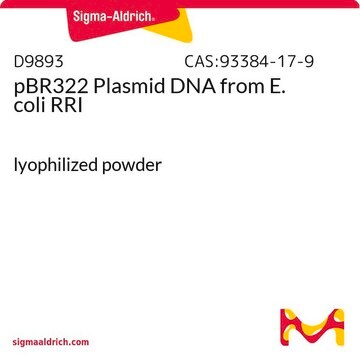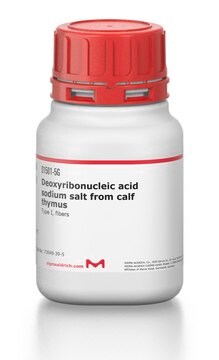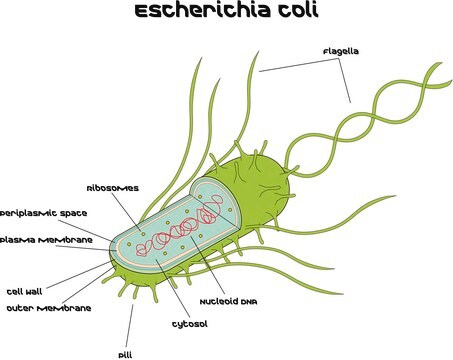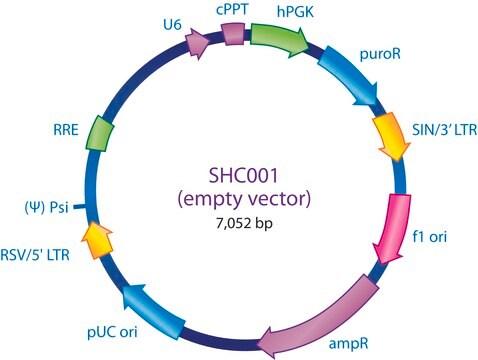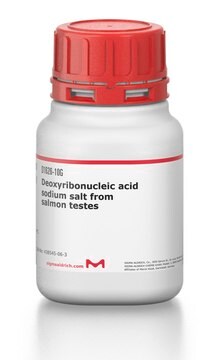D4904
pBR322 Plasmid DNA from E. coli RRI
buffered aqueous solution
Se connecterpour consulter vos tarifs contractuels et ceux de votre entreprise/organisme
About This Item
Numéro CAS:
Numéro CE :
Numéro MDL:
Code UNSPSC :
12352200
eCl@ss :
32160414
Nomenclature NACRES :
NA.51
Produits recommandés
Produit recombinant
expressed in E. coli
Niveau de qualité
Qualité
for molecular biology
Forme
buffered aqueous solution
Poids mol.
2.9 MDa
4363 bp
Origine de la réplication
BR322
Sélection
ampicillin
Conditions d'expédition
dry ice
Température de stockage
−20°C
Vous recherchez des produits similaires ? Visite Guide de comparaison des produits
Description générale
Plasmid pBR322 was one of the first multipurpose cloning vectors constructed for use in E. coli. This plasmid is derived from the ColE1-type plasmid pMB1 and shares the same type of replication mechanism and controls as ColE1 and relatives. Plasmid pBR322 confers resistance to ampicillin and tetracycline. The plasmid sequence has been published.
The plasmid has unique restriction sites within the gene for ampicillin resistance (Pst I, Pvu I, and Sca I), within the gene for tetracycline resistance (BamH I, BspM I, EcoR V, Nhe I, Nru I, Sal I, Sph I, and Xma III), and elsewhere (Aat II, Ava I, Bal I, Bsm I, BspM II, Cla I, EcoR I, Hind III, Nde I, Pvu II, Ssp I, Sty I, and Tth111 I).
The plasmid has unique restriction sites within the gene for ampicillin resistance (Pst I, Pvu I, and Sca I), within the gene for tetracycline resistance (BamH I, BspM I, EcoR V, Nhe I, Nru I, Sal I, Sph I, and Xma III), and elsewhere (Aat II, Ava I, Bal I, Bsm I, BspM II, Cla I, EcoR I, Hind III, Nde I, Pvu II, Ssp I, Sty I, and Tth111 I).
Spécificité
Unique Sites: Within the gene for ampicillin resistance: Pst I, Pvu I, Sca I; Within the gene for tetracycline resistance: BamH I, BspM I, EcoR V, Nhe I, Nru I, Sal I, Sph I, Xma III; other unique sites: Aat II, Ava I, Bal I, Bsm I, BspM II, Cla I, EcoR I, Hind III, Nde I, Pvu II, Ssp I, Sty I, Tth111 I.
Application
Plasmid pBR322 was one of the first multipurpose cloning vectors constructed for use in Escherichia coli. This plasmid and derivatives have been used for a number of purposes including cloning, selection and expression of recombinant molecules, construction of shuttle vectors and vectors for nucleotide sequencing, studies of elements involved in gene expression, as plasmid DNA standards, and as a model system for studies on prokaryotic plasmid replication.
pBR322 Plasmid DNA from E. coli RRI has been used to study about ferrous ion-induced strand breaks in the plasmid pBR322 are mediated through hydrogen peroxide.
Actions biochimiques/physiologiques
One of the most commonly used cloning vectors, pBR322, confers resistance to ampicillin and tetracycline. The DNA sequence of the entire plasmid has been published.
This plasmid is derived from the ColE1-type plasmid pMB1 and shares the same type of replication mechanism and controls as ColE1 and relatives.
Composants
DNA is provided in a solution of 10 mM Tris-HCl (pH 8.0) with 1 mM EDTA.
Autres remarques
Accession number: J01749
Produit(s) apparenté(s)
Réf. du produit
Description
Tarif
Code de la classe de stockage
11 - Combustible Solids
Classe de danger pour l'eau (WGK)
WGK 3
Point d'éclair (°F)
Not applicable
Point d'éclair (°C)
Not applicable
Équipement de protection individuelle
Eyeshields, Gloves, type N95 (US)
Faites votre choix parmi les versions les plus récentes :
Déjà en possession de ce produit ?
Retrouvez la documentation relative aux produits que vous avez récemment achetés dans la Bibliothèque de documents.
Jörg Flemmig et al.
European biophysics journal : EBJ, 36(4-5), 377-384 (2006-10-19)
Ferrous ion-induced generation of single and multiple strand breaks in the DNA plasmid pBR322 induces the formation of two new plasmid forms with altered electrophoretic mobility. The yield of these plasmid forms, the circular relaxed and the linear forms, depended
Ferrous ion-induced strand breaks in the DNA plasmid pBR322 are not mediated by hydrogen peroxide
Flemmig J and Arnhold J
European Biophysics Journal, 36(4-5), 377-384 (2007)
Charles J Addison et al.
BioTechniques, 37(3), 376-378 (2004-10-09)
Transformation of Escherichia coli plays an important role in recombinant DNA technology. Most current transformation protocols require that the cells be treated to attain a particular physiological state known as "competence," and this makes transformation procedures lengthy and arduous. Here
Notre équipe de scientifiques dispose d'une expérience dans tous les secteurs de la recherche, notamment en sciences de la vie, science des matériaux, synthèse chimique, chromatographie, analyse et dans de nombreux autres domaines..
Contacter notre Service technique